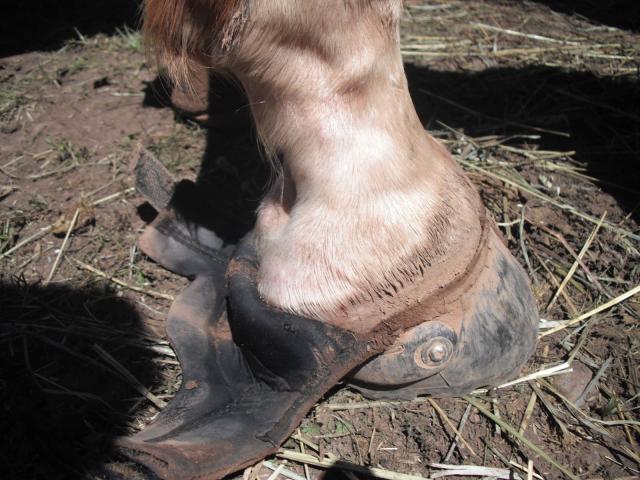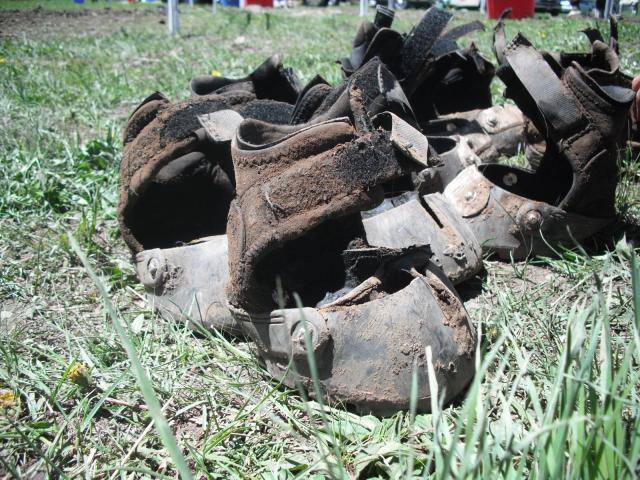I was addicted to glue. Easyboot Glue-Ons, that is.
I have to confess that when it comes time to compete at an endurance event, my tendency over the past 12 months has been to apply a nice set of four Easyboot-Glue-Ons to the horse.
It’s true that there is less to worry about with Glue-Ons: you just climb aboard and start the race without much heed to the boots. There are no gaiters to worry about rubbing or tearing; there is the extra cushion of Goober Glue in the sole of the boot to mitigate the concussion your horse will be going through. And I think I’ve ridden about 700 competition miles in Glue-On boots and have never lost one. So what if you need to spend an hour gluing on boots in the days leading up to the event? Why wouldn’t you glue on for a race?
Well, there are plenty of reasons, but for me one of the big reasons has been fear of getting pastern rubs over long distances.
The 2010 Strawberry Fields endurance event near Heber City, UT was the perfect testing ground to face my fear head-on of competing in Easyboot Gloves. The event location is known for its countless river crossings, its boggy, muddy conditions and the chance for precipitation. The results were nothing but successful.

Far’s front right foot after 105 miles through mud, bogs, water and rock.
The long and the short of it is that Far and I completed 105 miles in two days in Easyboot Gloves. We did not lose one boot, we did not rip any gaiters and we did not get any rubs. And there were four other horses in our EasyCare group that enjoyed the same results.
Equally interesting was to see that some of the so-called thought leaders in the barefoot community who use another boot brand who have been so vocally against glue-on boots were using glue-ons at the event. That definitely gives you something to think about.
Here’s how to overcome your fear of rubs:
- Stay on top of your barefoot trim: toe is bad; flare is bad; heel is bad. Maintain what your hoof practitioner has done by lightly rasping the hooves on a weekly basis.
- Build the number of miles you train in Gloves: if you go to an event thinking you can ride for eight hours on your first attempt, you’re in for trouble. Start with 30 minutes and build from there – quickly.
- Check your boots before you leave: make sure the screws are tight and the gaiters are in good condition. If your gaiters are looking tired, replace them with new ones for less than half the cost of a new boot.
- In wet, muddy conditions, clean the sole and hoof wall using a hoof pick and a wire brush. Make sure all the debris is removed and the hoof is clean. I used a hoof stand because I was putting boots on two horses before the race – it really saved my back.
- Wrap Mueller Athletic tape four times around the hoof – below the coronet band. Yes – four times! Don’t use vetwrap: it does not have the same sticking properties as athletic tape when it becomes wet or warm.
- Apply the boot using a subtle twisting movement to get it over the quarters and over the athletic tape.
- Use a rubber mallet to finish applying the boot before putting the foot down. Bang hard – and focus on the toe of the hoof.
- Place the foot on the ground, encourage the horse to put weight on that leg, and wrap the gaiter tightly. If it is too loose, debris could get in and rubs could occur.

I’ll definitely be using Gloves again at multi-day events. And you’ll probably see me in Glue-Ons from time to time as well.
Keep up the bootlegging!
P.S. To see more photos of the event, click here.
Kevin Myers





Audra, here is the tape we recommend: http://www.easycareinc.com/externallink.asp?C=ACCY7 – it is Mueller Athletic Tape, 1.5" wide. You can also get it in black or white at any of the big pharmacy chain stores. There is no video yet, but I will do one for you tomorrow morning before I go to the office.
What width athlectic tape do you use and cloth or paper tape?
Wrap it 4 times one layer on top of the other?
Is there a video?
Comments are closed.